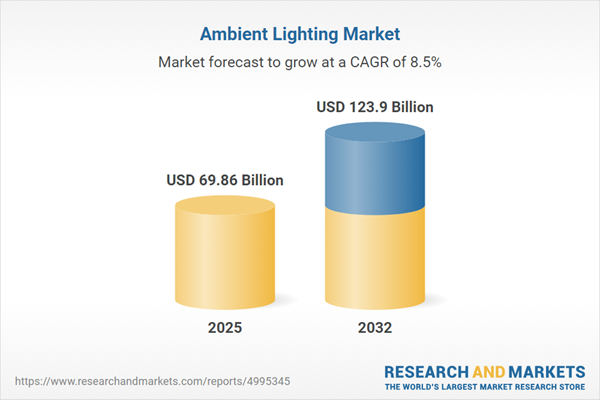Speak directly to the analyst to clarify any post sales queries you may have.
The ambient lighting market is experiencing significant momentum, driven by technological innovation and evolving design standards across global sectors. As demand intensifies for adaptable and sustainable illumination, businesses increasingly seek comprehensive solutions that enhance operational efficiency and user experience.
Market Snapshot: Ambient Lighting Market Size & Growth Trajectory
The Ambient Lighting Market grew from USD 64.41 billion in 2024 to USD 69.86 billion in 2025. It is expected to continue growing at a CAGR of 8.52%, reaching USD 123.90 billion by 2032. This robust expansion reflects both aggressive innovation cycles and a steady shift toward energy efficiency in commercial, industrial, and residential settings.
Scope & Segmentation: Ambient Lighting Market Coverage
This report provides a detailed analysis of the ambient lighting sector, highlighting the full value chain from raw materials to end-user applications. The segmentation encompasses:
- Product Types: Fluorescent, Halogen, Incandescent, LED (bulb, panel, tube)
- Installation Types: Portable (desk lamp, floor lamp), Recessed, Surface Mounted (track light, wall sconce), Suspended
- Technologies: Conventional, Smart (Bluetooth, Wi-Fi, Zigbee)
- Applications: Automotive, Commercial (office, retail), Hospitality, Industrial, Residential (indoor: bedroom, living room; outdoor)
- Distribution Channels: Offline (retail, wholesale), Online (direct sales, e-commerce)
- Regions: Americas (North America, Latin America), Europe Middle East Africa (Europe, Middle East, Africa), Asia-Pacific (China, India, Japan, Australia, and other key markets)
- Key Companies: Signify N.V., OSRAM GmbH, Hubbell Incorporated, Eaton Corporation plc, General Electric Company, Panasonic Corporation, Cooper Lighting Solutions LLC, Stanley Electric Co., Ltd.
Key Takeaways: Strategic Insights for Senior Leadership
- Digital transformation and LED technology are elevating operational efficiencies and enabling highly customizable lighting solutions tailored to user needs.
- Smart lighting platforms, empowered by Bluetooth, Wi-Fi, and Zigbee, are unlocking new value through real-time analytics, predictive maintenance, and adaptive scheduling, critical for contemporary facilities management.
- Manufacturers are prioritizing responsible sourcing and recyclable material integration, advancing sustainability and aligning with emerging regulatory frameworks across all regions.
- Advanced segmentation reveals that installation preferences—such as surface-mounted options in retail or portable solutions for hybrid workspaces—influence procurement strategies and facility designs.
- Growing adoption of online distribution channels is accelerating procurement cycles and enhancing buyer engagement, with digital configurators and virtual design tools becoming standard in commercial negotiations.
Tariff Impact: Navigating Regulatory & Supply Chain Challenges
Recent tariff revisions in the United States have challenged suppliers through increased costs on essential materials such as aluminum alloy and semiconductor components. Manufacturers are adapting by diversifying supply sources, enhancing inventory management, and leveraging global logistics partnerships. End-user organizations have adjusted expectations around procurement timelines and costs, with some adopting modular designs or localized assembly to counteract disruptions.
Methodology & Data Sources
This analysis is based on primary interviews with industry experts, executive stakeholders, and technical professionals. Secondary research includes regulatory documentation, public financial reports, market publications, and direct observations at industry events. Data validation used scenario analysis and rigorous segmentation criteria to ensure credibility and actionable insights.
Why This Report Matters
- Empowers decision-makers to identify emerging technology trends and proactively respond to shifts in the global ambient lighting landscape.
- Supports supply chain and procurement optimization by offering clarity on regulatory changes and evolving distribution models across key markets.
- Equips leaders with granular segmentation data for strategic planning and opportunity assessment in new and existing markets.
Conclusion
The ambient lighting sector is at a pivotal moment for technology adoption, supply chain strategy, and sustainability practices. Forward-looking organizations that integrate smart controls, digital experiences, and resilient sourcing stand well positioned to capture emerging opportunities and sustain long-term growth.
Additional Product Information:
- Purchase of this report includes 1 year online access with quarterly updates.
- This report can be updated on request. Please contact our Customer Experience team using the Ask a Question widget on our website.
Table of Contents
3. Executive Summary
4. Market Overview
7. Cumulative Impact of Artificial Intelligence 2025
Companies Mentioned
The companies profiled in this Ambient Lighting market report include:- Signify N.V.
- OSRAM GmbH
- Hubbell Incorporated
- Eaton Corporation plc
- General Electric Company
- Panasonic Corporation
- Cooper Lighting Solutions LLC
- Stanley Electric Co., Ltd.
Table Information
| Report Attribute | Details |
|---|---|
| No. of Pages | 193 |
| Published | October 2025 |
| Forecast Period | 2025 - 2032 |
| Estimated Market Value ( USD | $ 69.86 Billion |
| Forecasted Market Value ( USD | $ 123.9 Billion |
| Compound Annual Growth Rate | 8.5% |
| Regions Covered | Global |
| No. of Companies Mentioned | 9 |









